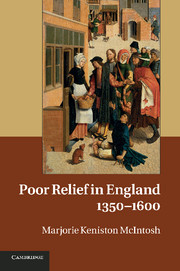Book contents
- Frontmatter
- Contents
- Acknowledgements
- Notes on conventions and online resources
- Abbreviations
- 1 Introduction
- Part I Late medieval and early Tudor patterns
- 2 Seeking alms
- 3 Late medieval hospitals and almshouses
- 4 Aid given through and by the parish
- Part II Profound change during the early Reformation period
- Part III Intensified problems and altered approaches in the later sixteenth century
- Part IV Responding to the problems
- Appendices included in the printed volume
3 - Late medieval hospitals and almshouses
Published online by Cambridge University Press: 05 January 2012
- Frontmatter
- Contents
- Acknowledgements
- Notes on conventions and online resources
- Abbreviations
- 1 Introduction
- Part I Late medieval and early Tudor patterns
- 2 Seeking alms
- 3 Late medieval hospitals and almshouses
- 4 Aid given through and by the parish
- Part II Profound change during the early Reformation period
- Part III Intensified problems and altered approaches in the later sixteenth century
- Part IV Responding to the problems
- Appendices included in the printed volume
Summary
A privileged sub-group of needy English men and women, probably numbering more than 5,000 to 6,000 people in the 1520s, were assisted in residential institutions. Hospitals and almshouses served a variety of inmates, stemming from the multiple and changing definitions of what kind of people were considered “poor” and deserving of help. Some residents had been incapacitated by a chronic illness (including leprosy), an injury, or a physical or emotional disability, while a growing proportion were elderly. Other institutions focused upon travelers, old priests, or the retired servants of particular families. Hospitals usually provided meals and at least simple care for their residents, many of whom were bedridden, while almshouses generally offered only housing and perhaps a few other benefits. The advantages and obligations of the residents reflected the two roles of such houses. While they were intended to provide a social service, most of them also functioned as centers of prayer. Some institutions were operated by a religious house or civic body, but many were independent or had a landed endowment held by feoffees. A rising number of almshouses were intended for female residents, and women were essential to the creation of many institutions: founding houses themselves, setting up institutions envisioned by their husbands, or supervising projects initiated by other deceased relatives.
Examination of these institutions and their residents is closely linked to alms seeking and charitable gathering. Regardless of their financial structure, all houses hoped to receive donations and bequests from the faithful. Such charity was promoted by the church, for visiting the sick and giving shelter to the homeless (or – vicariously – assisting an institution that looked after them) were among the seven corporal works of mercy. Most leper hospitals relied heavily on begging by their own residents, while some institutions sent out gatherers to solicit contributions. Because few almshouses provided full support, those residents who were mobile might need to ask individually for help to supplement whatever donations they received as unsolicited gifts and bequests. No legislation prohibited institutional dwellers from requesting aid in their own communities or required that they have a license.
- Type
- Chapter
- Information
- Poor Relief in England, 1350–1600 , pp. 59 - 94Publisher: Cambridge University PressPrint publication year: 2011



